|
|
Observing Highlights - Jul-Dec 2006Website archive 1995-2013 |
Victoria Centre is part of the national Royal Astronomical Society of Canada, which is dedicated to bringing information about astronomy to the general public. |
|
|
|
|
| |||||||||||||||||||||||||||||||||||||||||||||||||||||||||||||||||||||||||||||||||||||||||||||||||||||||||||||||||||||||||||||||||||||||||||||||||||||||||||||||||||||||||||||||||||||||||||||||||||||||||||||||||||||||||||||||||||||||||||||||||||||||||||||||||||||||||||||||||||||||||||||
| M42 - Orion Nebula & Running Man Nebula - Dec 28, 2006
Telescope: Orion 100mm. f9 ED on an HEQ5 Mount. |
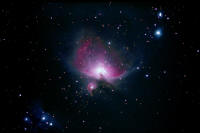 |
|||||||
| Rosette Nebula - NGC 2237-39, 2246 and NGC 2244 - 28
December 2006 Four members met at the old 16" site tonight. It was nice to finally have a clear sky. It gave must of us the opportunity to try out new gear. The astrophotographers focused on the Orion and Rosette nebulae. My plan was to wait for the quarter moon to set before proceeding to image the Rosette nebula. Unfortunately, clouds moved in at around 00:30 and I only exposed for about 13 minutes before packing up my gear. Charles Banville |
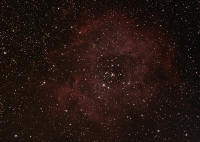 |
|||||||
| M42 - Orion Nebula & Running Man Nebula - Dec 28, 2006 I took another image of the Orion Sword region last evening with the idea of testing how well the upgraded HEQ5 was tracking. Tracking was very good at 2 minutes and the 4 minute exposure showed only a bit of mistracking. All exposures were useable and gave a fairly good image. The running man shows up well as does the faint nebulosity of the outer regions of M42. The center of M42 is overexposed so I tried combining with my previous best to see if I could capture a wider range of intensities. The result is the second image which represents my personal best for this target. John McDonald
|
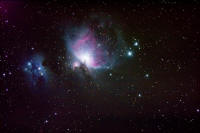
|
|||||||
| Rosette Nebula - NGC 2237-39, 2246 and NGC 2244 - Dec
28, 2006 Went to the hill with Charles, Bruno and Guy last evening and
planned to test the upgrade of my HEQ5 mount. The mount worked quite well
and I have now joined the ranks of the lazy astronomers with goto
capability. During testing I also tried some exposures of the Rosette Nebula
and the attached image is the result. It had a total of 13 minutes of
exposure which is not a lot for this diffuse target so the image needed some
fairly aggressively processing. I am pleased that I was able to tease out
some of the beautiful nebulosity.
|
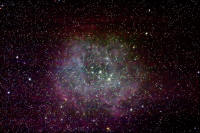 |
|||||||
| M42 Orion Nebula & Moon over Haleakala - Dec 5, 2006,
Maui, Hawaii Images from a session on Tuesday, Dec. 5 when I got to
the top of the 10,000 foot "Haleakala" volcano.
The image of the moon over Haleakala was a combination of two exposures to
tame the extreme range of the moons brightness and the surrounding twilight.
One was taken with the normal zoom lens at f=45mm and the other was taken
with a 400 mm telephoto lens and scaled to the size of the overexposed moon
in the first image. |
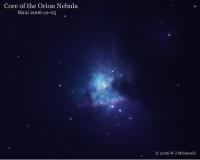
|
|||||||
| M52 & Double Cluster - Nov, 2006 Here are my first 2 images captured last fall, Processing was done in Jan. 07, after purchasing Images Plus. Many thanks to John and Charles who helped me do this first stacking effort. I'm sure that with more time, I'll be able to further develop my processing skills. |
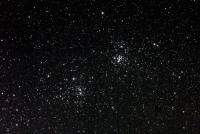 |
|||||||
|
Transit of Mercury & Sundog - Nov 8, 2006 Clear Sky Clock looked really good for Victoria this morning so off I went. I got half way up the Malahat when Joanne gave me the bad news. Clear Sky Clock for Victoria is now looking dismal. U-Turn on the Malahat and high tail it for Nanaimo. Sun in a cloud bank. Turn around at Nanoose Bay.. the sky breaks a bit...stop at Nanaimo park way rest stop. I got about two hours of sucker holes and some very good views of Mercury...Yes. I am happy ...fluffy clouds replaced by high haze...Oh well made for a nice Sun Dog. All in all I had a great day and am so pleased that I did see Mercury.
Brian Robilliard |
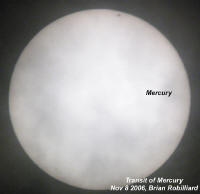
|
|||||||
| Transit of Mercury - Nov 8, 2006 From Metchosin I
had pretty much a similar experience with battling the clouds. I set up
under the covered stage at the Village Green, behind the Municipal Hall.
Under it's shelter I was able to observe, but would be protected from the
rain that never happened. |
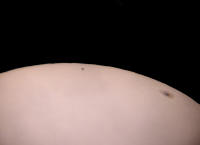 |
|||||||
| Transit of Mercury - Nov 8, 2006 This morning Joe
Carr and Guy Walton joined me at the parking lot near the machine shop to
view the Mercury transit. We had a perfect view except for the clouds and
occasional spots of rain. Just before the transit began the skies opened up
revealing the Sun. The views were still hazy but we imaged and view the
beginnings of the transit. Mercury is very tiny :-) but very visible.
Finally the clouds really set in and we had to call it a day. |
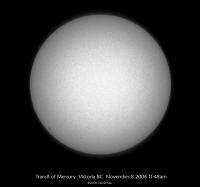 |
|||||||
| Transit of Mercury - Nov 8, 2006 David Lee, Guy Walton and myself observed the Transit of Mercury from Observatory Hill this morning under cloudy skies. We were treated to enough sucker holes in the clouds to allow us to both observe and photograph the first part of this event. Personally, this was thrilling - my first transit, and my first Transit of Mercury! As you will see, the photographs have poor resolution due to all the cloud we were shooting through, but the progress of the Transit is clearly visible (7 o'clock position), as is the quite large sunspot (8 o'clock position). |
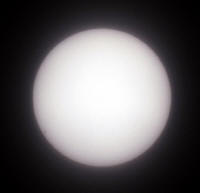 Mercury Transit through the clouds, taken 10 minutes after start |
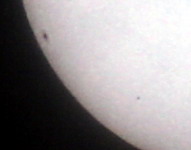 Mercury Transit through the clouds, taken 38 minutes after start |
||||||
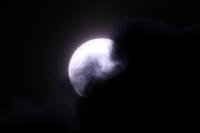 Mercury Transit - Mercury obscured by more clouds, taken 39 minutes after the start |
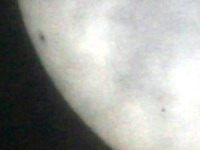 Mercury Transit through the clouds, taken 45 minutes after the start |
|||||||
| Comet Swan at Otter Point - Oct 30, 2006 It was a
great evening of imaging at Sandy Barta's Otter Point site. A little bit
cold for warm-blooded creatures but a far superior dark sky in spite of the
Moon hanging in the sky to the south. As night approached the constellation
Hercules was framed perfectly between the trees facing west. With the change
in daylight savings time it was dark by 6:30pm. Near 58-Epsilon Herculis was
the fuzzy ball called Comet Swan that we've been chasing from city skies.
|
 |
|||||||
| Comet C/2006 M4 Swan - Oct 30, 2006 My latest image of Comet Swan was taken Monday evening when David Lee and I travelled to Sandy Barta's place to find some dark sky. The dust tail is super long (over 3� in this image), and if you look closely you will see a short ion tail just to the right of the big one. The head of this comet is so huge and bright, I could easily spot it in my finder scope. The image shows the head is not perfectly round, which indicates the comet is fragmenting. The bright star below the comet is 58-Epsilon Herculis. |
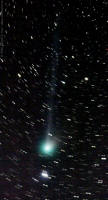 |
|||||||
| Comet C/2006 M4 Swan - 29 October 2006 Guy and I were treated with excellent viewing conditions last night at the DAO. We both imaged comet SWAN and here is my result. The tail of the comet is so long I could not frame it all! |
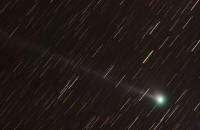 |
|||||||
| Comet C/2006 M4 Swan & M33 - Oct 29, 2006 Here are
my images from last night at the Old 16" Site at the DAO. |
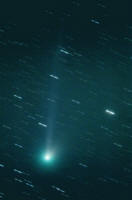 |
|||||||
| Comet Swan - Oct 21, 2006 This image is taken through the fog that has been back lighted from the lights on the playing field just west of Observatory Hill. You can see a hint of a tail and some dust on my CCD sensor. This is the first light for my modified Nikon. |
||||||||
| M33/NGC 598 - 20 October 2006 Taken: 20 October 2006 from Bruno's backyard in Oak Bay. |
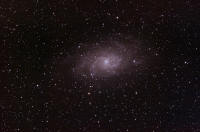 |
|||||||
| IC 5146 Cocoon Nebula - October 21, 2006 Taken at
home in Courtenay. |
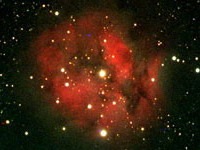 |
|||||||
| Comet Swan - Oct 21, 2006 This image is taken
through the fog that has been back lighted from the lights on the playing
field just west of Observatory Hill. You can see a hint of a tail and some
dust on my CCD sensor. This is the first light for my modified Nikon. |
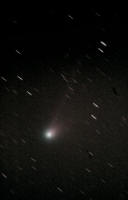 |
|||||||
| M33/NGC 598 - 20 October 2006 Taken: 20 October
2006 from Bruno's backyard in Oak Bay. |
 |
|||||||
| M31, M32, M110 - Oct 20, 2006 With a few clouds and fog conditions, I was able to capture 20 light frames of M31. Many thanks to Charles for his help and introducing me to Images Plus Processing... This is my first attempt... just aligned and stacked... Now to learn about PhotoShop |
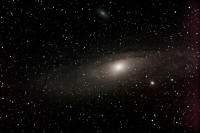 |
|||||||
| Comet C/2006 M4 Swan - Oct 16, 2006 Last night at the Astronomy Cafe Joe Carr and I both had a go at getting an image of Comet Swan. It was a mixture of rapidly changing clear and cloudy conditions and the parking lot lights were a bit close. The conditions were such that I did not think we would see the comet but Joe found it very quickly with his new 8" SCT goto and I soon followed with my (non goto) 105mm refractor. The clouds obscured most of the reference stars so I used the nearest cloud I saw in Joe's finder to locate it. Will have to remember that cloud so I can find it again. We both could see the nucleus clearly and each of us captured some frames during the breaks in the clouds. I was able to process 13 of the 17 frames I got. The others were marginal as a result of light pollution and a bit of mistracking. The fairly prominent star trail below and left of the comet is HIP70517. John McDonald |
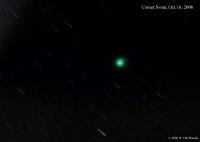 |
|||||||
| Comet C/2006 M4 Swan - Oct 16, 2006 I managed to
use 9 images for this stacked image of Comet C/2006 M4 Swan. Canon 30D, 30
seconds, ISO 3200, Canon EF 400mm f/5.6L telephoto operating at f/6.3,
piggybacked on my LX-200R tracking on the comet. Processed using ImagesPlus,
sigma clipped average 1.4, and NeatImage.
|
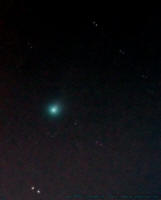 |
|||||||
| Sun Halo - Oct 5, 2006 I took the attached photo on my way home from work. While it is not an "astro photo" as such, it does relate to the heavens. |
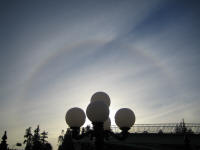 |
|||||||
| M31, Andromeda Galaxy - October 4, 2006 - 10 images taken with a Canon Digital Rebel, mounted prime focus on a Mead LX-200 GPS 10" and an Antares f/6.3 focal reducer. 20 sec, ISO 1600, stacked using ImagesPlus by Charles Banville. |
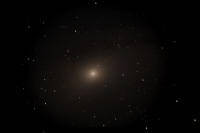 |
|||||||
| NGC 457, ET Cluster - October 4, 2006 - 4 images taken with a Canon Digital Rebel (in-camera noise reduction on), mounted prime focus on a Meade LX-200 GPS 10" and an Antares f/6.3 focal reducer, 20 sec, ISO 1600, processed in ImagesPlus by Charles Banville. |
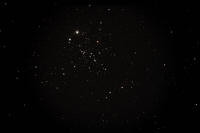 |
|||||||
| Moon - October 4, 2006 - A composite of two images taken with a Canon Digital Rebel, mounted prime focus on a Meade LX-200 GPS 10" and an Antares f/6.3 focal reducer. 1/1000 sec, ISO 800, processed in ImagesPlus by Charles Banville. |
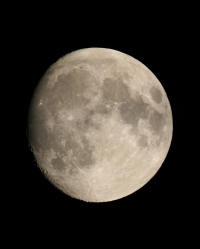 |
|||||||
A series of pictures taken from the old 16
inch site (DAO) Sept 29th / 30th, 2006 -
Malcolm Scrimger
The camera is a Nikon D70s on a tripod - no tracking. |
||||||||
| NGC7789, an Open Cluster & NGC5907, Splinter Galaxy -
Sep 29, 2006 Several members had a good observing session atop
Observatory Hill on Friday night. We enjoyed wonderfully warm temperatures
as we were above the fog bank enveloping much of the city, and the air was
quite stable - a bonus for those of us who are astrophotographers. |
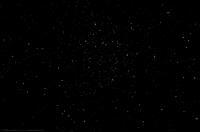
|
|||||||
| Horsehead Nebula, Flame Nebula - Sep 27, 2006 I spent some sleepless nights last week. One resulted in the image of the Orion Nebula (below). I was pretty happy with that. However, two nights trying to image the region of the Flame and Horsehead nebulae resulted in only limited success. This was despite taking a total of 70 - 1 min light frames at ISO 800 and the same number of darks. Fog and poor transparency spoiled some frames and I messed up others trying out some noise correction ideas that did not work out. As a result, I was only able to use 18 of the 70 frames. The image has less detail than I had hoped as a result (see attached). It is possible to make out the horsehead nebula (just) and the Flame and NGC2023 nebula are evident. The overexposed object near the flame is the left end belt star of Orion and the irregular shaped blue object below the horsehead is NGC2023. John McDonald |
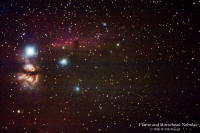 |
|||||||
| Sword or Orion, M42, Orion Nebula - Sept 26, 2006 This is pushing the season but I got up very early this morning (3:45am) and Orion was so beautiful I set up in the back yard and imaged it. The result is attached. It is a bright object but the range of intensities is extreme so I used a combination of exposure times and combined the results. In the shortest exposures the trapezium was well resolved but it sits on such a bright region it does not show up in the final image as much as I would like However it is just visible. |
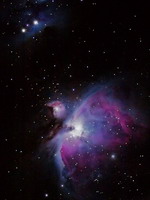 |
|||||||
| NGC 6992/5 Veil East - September 24, 2006 Taken in
Merritt at the star party. |
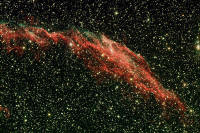 |
|||||||
| M31, M32, M110 and NGC206 - Sept 23, 2006 I took this image last night at the old 16" site. I used my 102mm, f5 Antares achromatic refractor. Except for some chromatic aberration on a few of the bright stars, it is my best of the Andromeda Galaxy area. |
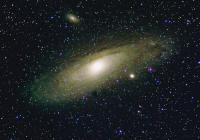 |
|||||||
| The Ring nebula is a tiny jewel - Sept 23, 2006 I am still a fan of wide field views of the sky and am attaching two views of M57 that I got last evening at the DAO. The first is a full frame image with my Williams Optics 105mm with 0.8x focal reducer for an effective focal length of 588 mm. As you can see the ring is really tiny but I like the sight of it this way, a jewel that you have to look for or you may miss it. The second image is a crop to get a better look at the nebula itself. |
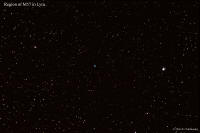
|
|||||||
| M45, Pleiades - Sept 23, 2006 - Last night on the
Hill the skies were nice and dark, especially after 11 when the lights went
out at the Centre of the Universe. Having stayed on the observation deck
most of the time I have to agree with Joe that the parking lot is a better
spot. Before 11 Brenda and I wandered through a tour of doubles Gamma
Andromeda, the Double Double, the nose star of Delphinus, Albierio and
Polaris. The Double Cluster in Perseus and the ET Cluster were beautifully
crisp. After 11 I tried my first imaging for quite a while as I've just started to acclimatize to my new telescope and mount combination. The longer tube of the NP101 has made balancing the scope a little more challenging but I'm starting to get the hang of it. Here's an image of the Pleiades from this morning with some nebulosity. It's needs some work but I can see the possibilities. David Lee |
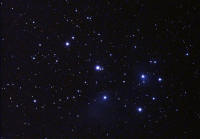 |
|||||||
| M51 - Whirlpool Galaxy - Aug 27 & Sept 21, 2006 Charles and I went to the hill last evening and enjoyed better than advertised conditions. The Temperature was 13 deg. C, there was no wind and the sky was clear with good seeing. I tried imaging M51 and got 39 minutes worth of light frames (39x 1min exposures). After processing I did a weighted average combination with the 10 minute exposure image I got at the Sask. Summer Star Party. |
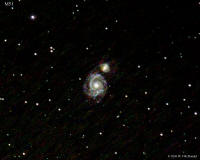 |
|||||||
| M20 & M21 - Summer 2006 - With the recent [bad November] I noticed some murky images of M20 during some sessions at Cattle Point. Through some selective masking I was able to salvage a widefield image of M20 and surprisingly a nearby neighbour M21. I'm always happy to discover these little gems because I often ignore them in the eyepiece when you're concentrating on a target such as M20. The open cluster M21 is quite pretty and has an interesting pattern of stars. |
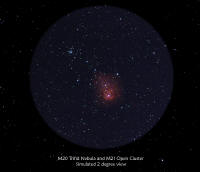 |
|||||||
| M27, Dumbell Nebula - June 29, 2006 Location: in
Courtenay |
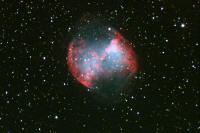 |
|||||||
| Moon - SMART-1 Impact - Sep 2, 2006 10:42:15pm PDT Several members observed the SMART-1 lunar satellite impact from Observatory Hill. I used my Meade LX-200R 8" and the Meade LPI imager to take a total of 1,584 jpg frames covering the event from 10:37:48pm to 10:49:28pm PDT. The image to the right links to a 2 minute video extracted from the middle of this sequence, covering the event 1 minute either side of the impact, which occurred at 10:42:15pm PDT. I don't see any impact or resulting plume in the terminator region in my video, however the CFHT successfully took an Image of SMART-1 Impact. Please view my video and let me know if you spot anything. Finder chart (257k jpg). Joe Carr |
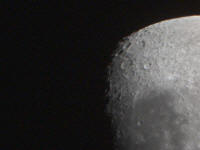 [4.7Mb AVI movie] Please note: I used the Indeo 5.10 codec to compress this AVI. If you have trouble playing the video on your computer, please follow the codec installation instructions on this page. |
|||||||
| NGC 7789, Open Cluster - Aug 31, 2006 Here is an Image I did last night at the Old 16" Site: |
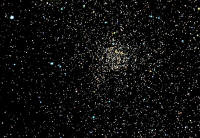 |
|||||||
| M31, M32, M110 - 28 August 2006 Guy Walton and I went to the DAO last Sunday. I took this picture of the Andromeda Galaxy from the old 16" site. Transparency was poor, thin layers of clouds covered the sky. All my 72 shots were graded "F" by ImagesPlus, likely the result of poor seeing. Nonetheless, my final result looks good. Notice NGC 206, the star cloud within M31, clearly visible in this frame. Charles Banville |
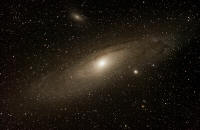 |
|||||||
| M101, Pinwheel Galaxy - Aug 27, 2006 I have acquired images of M101, Pinwheel Galaxy over three nights in the last while. It is a very difficult object to image, mainly because its surface brightness is so low. This is a composite image of a stack of 25 of the best images. |
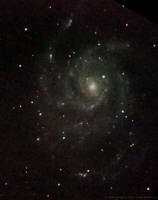 |
|||||||
| Melotte 15, IC 1795 and NGC 896 - 27 August 2006 Located in Cassiopeia, IC 1805 nebula covers a wide field of view. I was able to capture only part of it in my frame. The open cluster in the centre of this image is Melotte 15 (mag 6.5; 20'). The nebulae IC 1795 and NGC 896 are in top right corner. Half way between NGC 896 and Mel 15 lies the faint open cluster Tom 4 (from Clyde Tombaugh's Small List of Open Clusters). Charles Banville |
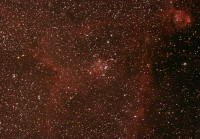 |
|||||||
| M13, M27, M52 & NGC7635 - Aug 26, 2006 Last night we set up at the old 16" site. I used "ImagesPlus", that is installed on my laptop, for a controlling the camera and saving the images directly to the computer. This method is great because I can see if the camera is focussed and if I am getting the desired composition. One can program in the sequence of exposures and let the computer operate the camera. Here are some images from last night. I was having tracking problems with M13 which were probably due to some imbalance and had to discard may exposures. |
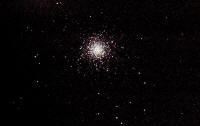
|
|||||||
| NGC 281, Pacman Nebula / IC 1590 - 25 August 2006 Joe, Guy, Malcolm, and I went to Cattle Point last night. While my dew heaters were fighting the high humidity, I obtained this picture of NGC 281. This emission nebula is located in Cassiopeia. Also known as the Pacman Nebula, NGC 281 surrounds the small open cluster IC 1590. Charles Banville |
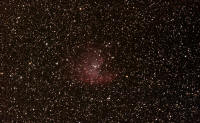 |
|||||||
| M45, Pleiades - Aug 24, 2006 This image of the Pleiades is taken from Cattle Point last night when they were only 20� above the horizon in the NE sky after midnight. Despite the heavy moisture content in the air, Guy, Charles and I continued to take images, fighting off the dewing as best we could. |
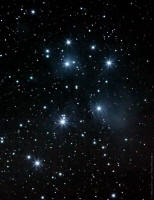 |
|||||||
| NGC6960, the Western Veil Nebula - Aug 24, 2006 This image of NGC6960, the Western Veil Nebula is also taken from Cattle Point last night . This is my first image of the Veil Nebula. |
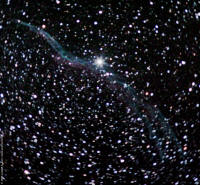 |
|||||||
| NGC 6939 and NGC 6946 - 20 August 2006 Another picture taken from Pearson College following the annual picnic. NGC 6939 is an open cluster (10' x 10') of magnitude 7.8 and NGC 6946 a spiral galaxy of magnitude 8.8. The pair lie in Cepheus. Charles Banville |
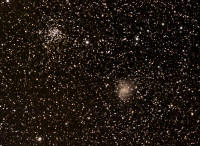 |
|||||||
| Kemble's Cascade and NGC 1502 - 20 August 2006 Kemble's Cascade is a two-degree-long chain of fifth-to-eight-magnitude stars. Named after Canadian observer Father Lucien Kemble (1922-1999), it is located in Camelopardalis. I managed to get this picture of the Cascade last Saturday following the Centre's annual picnic at Pearson College. North is up in this image and Kemble's Cascade runs from the top right corner down to the open cluster NGC 1502. The small cluster looked very interesting through Bill Weir's telescope. It reminded us of the ET cluster (NGC 457); indeed, two of the stars in the cluster appeared as a pair of eyes looking back at us. Charles Banville |
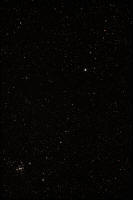 |
|||||||
| Milky Way: Sagittarius & Cassiopeia - Aug 19, 2006 I had a great time at the Pearson College picnic. The sky viewing was fantastic - nice and dark. |
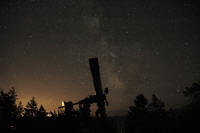 |
|||||||
| NGC 7129 and NGC 7142 - 19 August 2006 A few members met at Cattle Point this past Friday. I imaged this pair of objects located in Cepheus. NGC 7129 is the reflection nebula/open cluster. The open cluster NGC 7142 (12' x 12', magnitude 9.3) is to the right of NGC 7129. If you're looking for a challenge, try locating PGC 97261. At magnitude 16.4, this galaxy appears as a bare speck in this image. Charles Banville |
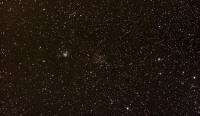 |
|||||||
| M11, the Wild Duck Cluster - August 18/19, 2006 Here is an image I did of M11, the Wild Duck Cluster at Pearson College. |
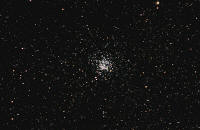 |
|||||||
|
Big Dipper - August 2006 This was a tripod shot for 30s at ISO 800 with the lens at 18mm and f5.6. Processed and cropped using Photoshop and Astronomy tools. Location: Canmore, Alberta John McDonald |
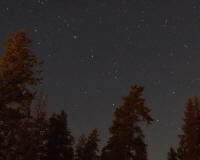 |
|||||||
|
Moon and Three Sisters- August 2006 This is a combination of three exposures As the moon was rising and passing behind the Three Sisters mountains. I thought each sister deserved a moon shot as it passed close by. You can see two of the sisters on the left and center with the tip of the third peak just visible on the right. Location: Canmore, Alberta John McDonald |
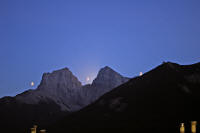 |
|||||||
|
M51 - Whirlpool Galaxy- August 2006 Location: Saskatchewan Star Party 2006 The evening started out with an amazingly clear sky but unfortunately a strong wind came up as I was imaging M51 so I did not get nearly as much exposure time on it as I would have liked. The result is not bad considering I could only use 10 light frames. John McDonald |
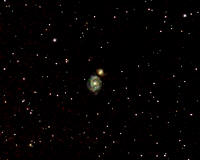 |
|||||||
|
Setting Moon at the Meadows Campground - August 2006 Location:Saskatchewan Star Party 2006 |
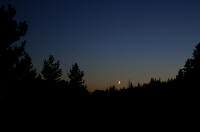 |
|||||||
|
Andromeda Galaxy - August, 2006 This is my personal best for M31. I benefited from a very clear dark sky at the Saskatchewan Star Party 2006 and some inspiration from Jack Newton. |
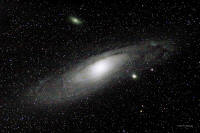 |
|||||||
| The Iris Nebula - NGC 7023 - 18 August 2006 I took this picture of the Iris Nebula from Cattle Point on Thursday night. The small reflection nebula (10' x 8') is located in Cepheus and surrounds a 7th magnitude star. Of interest in this picture is the Mira-type variable star T Cephei (HD 202012). Look for the bright reddish star located in the bottom left corner of this image. T Cephei has a period of 388 days and fluctuates between magnitude 5.2 and 11.3. |
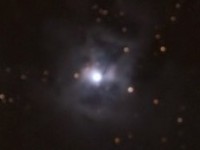 |
|||||||
| Andromeda Galaxy - M31, M32, M110 - Aug 18, 2006
Last night several of us went to Cattle Point, and had a good
observing/photo session. The air was quite stable, although there was
considerable moisture in the air. I wanted to add to the 7 guided images of
Andromeda Galaxy taken a few nights before. The attached image is a stack of
30 images, which has produced my deepest image of Andromeda to date. |
 |
|||||||
| Moon about to occult the Pleiades - Aug 16, 2006 5:01am -I had a look at the moon about to occult the Pleiades and it was nice although the moon really overwhelms the stars. Nevertheless I tried a few tripod shots using a Pentax DSLR and telephoto lens. This image is a combination of exposures to show how it might have looked if our eyes could handle the extreme range of light intensities. John McDonald |
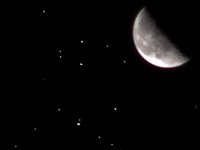 |
|||||||
| The Sun - 16 August 2006 - After borrowing a few bits and pieces from Bruno, I thought I'd give solar photography another try. I drove to Mount Tolmie Park on Wednesday and pointed the Centre's Coronado Solarmax telescope at the Sun. I started shooting using Bruno's 2.5x Powermate but found eyepiece projection method more forgiving. This image was acquired using an 18mm Coronado eyepiece. I took a series of short exposures (1/320 to 1/800) to emphasize the details on the surface of the Sun and somewhat longer exposures (1/125) to capture Sun's flares. Thanks to John McDonald for superimposing and blending my two sets of images. Charles Banville |
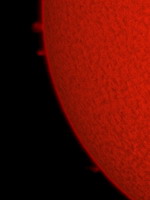 |
|||||||
| Andromeda Galaxy - M31, M32, M110 - Aug 14, 2006 Malcolm Scrimger and myself observed from Cattle Point until the Moon rose, giving us about 1.5 hours of dark skies. This is the deepest image of Andromeda I've achieved to date, and is also my first guided astrophotograph. Joe Carr |
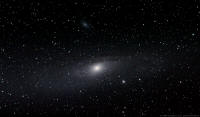 |
|||||||
| NGC 457 - ET Cluster - Aug 13, 2006 After doing the image of NGC 457 (ET cluster) earlier, I wondered if the color of the stars could be brought out better. My earlier attempt used 60 sec. exposures that overexposed the brighter stars so I tried again last evening taking exposures of 1 sec and 15 sec to combine with the 60 sec. ones. This image is a combination of all three and I think it does capture more of subtle colors fairly well. |
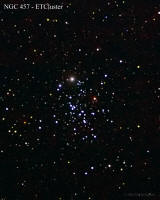 |
|||||||
| NGC 457 - ET Cluster - Aug 11, 2006 Last night Joe, David, Charles, Guy and I were at the 16" site and I took the attached image of the ET (Owl) Cluster. Given the ET connection I thought I could get a little fanciful in the processing and added diffraction spike using Astronomy Tools. |
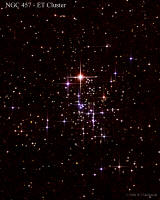 |
|||||||
| Morning Stars Rising - 7 August 2006 Here's how the eastern sky looked early this morning from Mount Tolmie Park. Gemini and Orion are seen rising above the horizon while Capella (in Auriga) and the Hyades (in Taurus) are well above it. I observed both Venus and Mercury naked eye. In this picture, Venus, at magnitude -3.9, appears as a bright star below Castor and Pollux in Gemini. Mercury, at magnitude 0.1, is harder to see in this image. It is located approximately 2.5 degrees below Venus (barely clearing the horizon). Charles Banville |
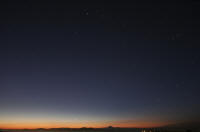 |
|||||||
| NGC457 or the ET Cluster in Cassiopeia - August 5, 2006
- A combination of 13, 30 second exposures at ISO 1600 with noise
reduction on: NGC 869 and 884, the Double Cluster in Perseus - August 5, 2006 - A combination of 13, 30 second exposures at ISO 1600 with noise reduction on. Last night was great and for those that are scared of a nearly full moon, we had very good seeing conditions plus a nice warm evening [on Observatory Hill]. |
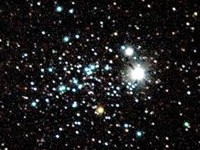 |
|||||||
| Double Cluster in Perseus - Aug 5, 2006 - Looks like several of us focused on the Double Cluster in Perseus during the recent moonlit nights. On Saturday night at the Centre of the Universe I spent most of my time enjoying incredibly stable views of the Moon and Jupiter that accompanied the good seeing. I wasn't planning on doing much imaging but did get a few frames of the double cluster and was rewarded with a much more detailed image of it I have obtained so far. The good seeing certainly helped and the WO scope and HEQ5 mount all performed well. John McDonald |
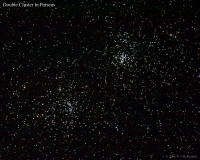 |
|||||||
| The Veil Nebula (Eastern Segment) NGC 6992 and NGC 6995
- 5 August 2006 Here's an image I took of the Eastern section of the Veil Nebula. It was taken early Saturday morning from Cattle Point. The seeing conditions were not great, the air was full of moisture. I waited for the moon to set, at around 01:00, before proceeding with the shoot. |
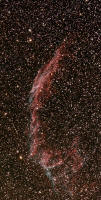 |
|||||||
| The Cocoon Nebula IC 5146 and Barnard 168 - 2 Aug 2006 I set up at Cattle Point on Tuesday night and aimed my scope towards the Cocoon Nebula in Cygnus. It was a bit windy but I was able to expose for over two hours. Also captured in this image is the dark nebula B168. Charles Banville |
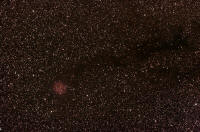 |
|||||||
| Eastern Veil Nebula - July 26, 27, 2006 I had some success last night at Cattle Point. This is an image of the Eastern Veil Nebula that is a crop of combined frames from June 26 and July 27. Like the Western Veil which I imaged recently, this subject is faint enough that it is pushing what is possible with my camera. |
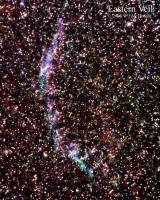 |
|||||||
| M27, Dumbell Nebula - July 26, 2006 Charles Banville, Malcolm Scrimger and myself went to Cattle Point last night to observe. I was testing my new Meade LX-200R 8" Ritchy-Chr�tien (third light), so I decided to image an object I've already imaged before so I could compare. |
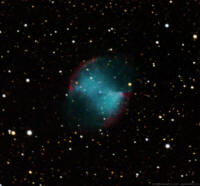 |
|||||||
| M8, Lagoon Nebula July 25 and 26, 2006 I have been combining all the frames I have from two imaging evenings on the Lagoon Nebula and the attached is the result. I was able to tease out some of the faint nebulosity without getting the image too noisy and I like the result. |
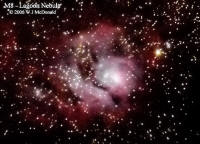 |
|||||||
| NGC 6888 The Crescent Nebula - 25 July 2006 I headed for the Hill on Monday night after an invitation from David Lee. Once there, I set up at the old 16" site and took this picture of the Crescent Nebula. The nebula, also known as Caldwell 27, is located in Cygnus. This is a cropped image. Charles Banville |
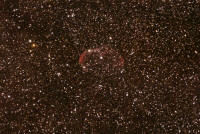 |
|||||||
| The Double Cluster (NGC 884 and NGC 869 ) - 23 July 2006 The Cowichan Valley StarFinders held their star party on the Malahat this past weekend. The weather was perfect for camping and observing. I spent Friday night observing the night sky and took this picture of the Perseus double cluster on Saturday night. Charles Banville |
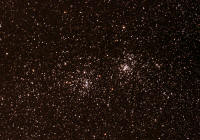 |
|||||||
| Andromeda Galaxy - M31, M32 - July 21, 2006 Here is an image of our old friend Andromeda Galaxy M31 & M32. The detail in the dark lanes of M31 are the best I've achieved so far. |
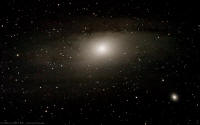 |
|||||||
| The Pelican Nebula (IC 5067) - 21 July 2006 Taken: from the DAO, the old 16" site. 67 light frames of 60 sec @ ISO 800 |
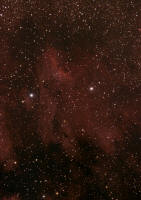 |
|||||||
| Deer Lick Group, NGC7331 - July 20/21, 2006 A few of us took advantage of the good weather the night before the Island Star Party by observing from Observatory Hill on July 20/21. I decided to try photographing a new and interesting object, the Deer Lick Group from the old 16" site as I fought off the mosquitos. In addition to the large galaxy NGC7331 which dominates this image, several satellite galaxies are also visible: NGC7335, NGC7336, NGC7337 and NGC7340. There was not much to see visually, but this group photographs quite well. Joe Carr |
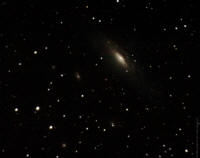 |
|||||||
| Western Veil Nebula - July 20, 2006 I have tried to image parts of the Western Veil on two occasions and the image shown here is a portion of the section near the star, 52 Cygni from a combination of two of them. This nebula is quite faint in my camera and could use a lot more exposure but I was pleased to get as much as I did. |
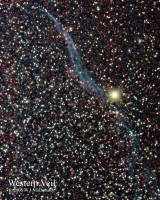 |
|||||||
| Gamma Cygni Nebula (IC 1318) - 19 July 2006 John and I had exceptional seeing conditions at Cattle Point, so I was able to expose part of the Gamma Cygni Nebula (IC 1318) for over 60 minutes. Notice the open cluster NGC 6910 on the left. |
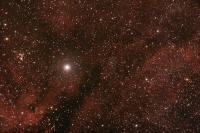 |
|||||||
| M16, Eagle Nebula - July 18, 2006 My image of the Eagle nebula is not as good as I hoped for as the lights from Oak Bay were producing quite a lot of sky glow low in the south. Nevertheless, the small dark eagle shape does show up in the centre. I hope to get more exposures to fill out the extended nebulosity region in another go when I get the chance. |
 |
|||||||
| IC 1396 / VdB 142 - 16 July 2006 I went to the DAO last night and set up at the old 16" site. I have captured part of the large emission nebula IC 1396 located in Cepheus. North is up in this picture. The bright double or multiple star in the centre of the frame is SAO 33626. To the right of it is VdB 142 which is also known as the elephant's trunk nebula. The dark nebula Barnard 161 is located north of SAO 33626. Two more dark nebulae, B163 and B365 are also visible in the bottom of the frame. |
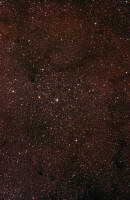 |
|||||||
| M52 and NGC 7635 - 16 July 2006 Another image from last night. M52 and the Bubble Nebula (NGC 7635) located in Cassiopeia. A Televue PowerMate was used for this shot. |
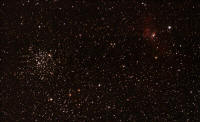 |
|||||||
| M31 Andromeda Galaxy and M110 - July 15, 2006 Last night, I finally got my CEQ mount polar aligned so it tracked quite well. Here is another M31. The camera framing cut off the star cloud to the extreme right. |
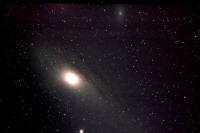 |
|||||||
| M82,
Cigar Galaxy - July 15, 2006 Last night on Observatory Hill I decided to concentrate on imaging each of the two Messier objects M81 and M82 individually. Here is the M82 Cigar Nebula image after processing. |
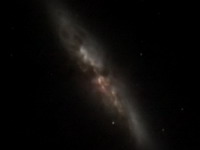 |
|||||||
| M81, Bode's Galaxy - July 15, 2006 I'm not nearly as pleased with this image as the M82 image (above). This object will obviously require many more 30 second images, and/or a longer exposure than 30 seconds. The low surface brightness makes it a difficult object to image using a dSLR at f/10. |
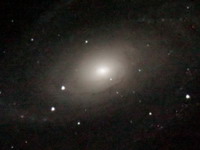 |
|||||||
| M27, Dumbell Nebula - July
15, 2006 The weather turned out to be very good for observing [on Observatory Hill], we had an excellent evening. I spent my time getting more exposure time on M27, the Dumbell Nebula. The attached is a combination of exposures from the July 2/3 and 15/16 late night attempts. I wanted to get enough exposure to show this nebula's color without excessive noise. John McDonald |
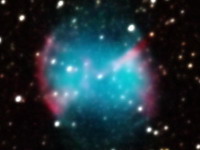 |
|||||||
| M3, Globular Cluster - July 8, 2006 1:15am I have found that the brighter Globular Clusters can be observed from my light-polluted location at home, so given that we were at the Centre of the Universe with an almost Full Moon staring at us, I decided to try imaging M3. |
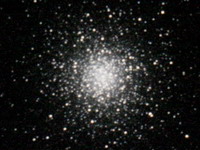 |
|||||||
| NGC 6960 The Filamentary Nebula - 3 July 2006 It was kind of windy yesterday night at Cattle Point. But by midnight the wind had subsided. I was hoping to get the whole of the Veil Nebula in the frame but came short. The western segment of the Veil Nebula (NGC 6960) is on the right side of this image. The bright star is 52 Cygni. NGC 6967 and 6974 are visible on the left. |
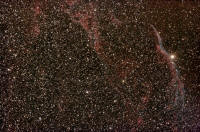 |
|||||||
| NGC 7000 The North America Nebula - 2 July 2006 Saturday was a great night at the DAO. Seeing conditions were exceptional and I focused my attention on the North America Nebula in Cygnus. |
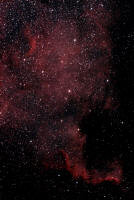 |
|||||||
| M27, Dumbell Nebula - July 2, 2006 Here is a relatively wide field image of the Dumbell nebula from last night at Cattle Point. It was another wonderful night although the wind made it difficult to do high magnification imaging. I resorted to doing a wide field of the Dumbell and have attached a cropped version that still covers a relatively wide field (about half the full frame by width). |
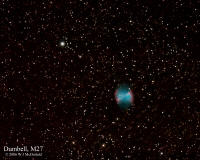 |
|||||||
| M8, Lagoon Nebula & M20, Trifid Nebula - 1 July 2006 Taken : 1 July 2006 from Pearson College. Telescope: TeleVue NP-101 f/5.4 on Vixen GP-DX mount. Camera: Canon 20Da Exposures: 20 light frames of 60 sec @ ISO 800. 15 darks, 15 flats and 15 bias frames. Processing: ImagesPlus |
||||||||
| NGC7000, North America Nebula - July 1, 2006 12:25am This is how I finished off our observing session at Cattle Point - shooting the N.A. Nebula using my Canon 400mm telephoto and 30D dSLR piggybacked on my Meade LX-90. Charles Banville and John McDonald had both imaged this nebula with good results, so I wanted to see what my gear would deliver. Again, I used ISO 3200 at 30 second exposures, and again, when I processed the 30 original images, there were 27 keepers. This allowed me to enhance the overall signal-to-noise ratio, and supported my aggressive digital development of the resultant image you see here. Joe Carr |
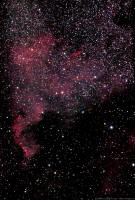 |
|||||||
|
M42, Orion Nebula - 2006 Earlier this year I took this image of M42 with the Centre's Takahashi and Meade's ill-starred Deep Space Imager, then promptly forgot about it until recently. The Tak's drive was not working properly so I simply hoped for the best. |
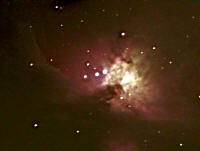 |
|||||||
|